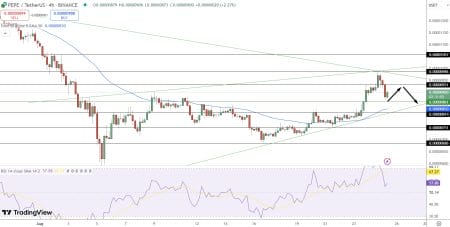Last updated:
 Why Trust Cryptonews
Why Trust Cryptonews
Ad Disclosure
We believe in full transparency with our readers. Some of our content includes affiliate links, and we may earn a commission through these partnerships.

Dogecoin, one of the most recognizable meme coins, experienced a severe setback on December 12 after a hacker exploited a vulnerability that caused 69% of its network nodes to crash.
The exploit, executed by Andreas Kohl, co-founder of Bitcoin sidechain Sequentia, demonstrated the network’s fragility and raised pressing questions about the robustness of cryptocurrency ecosystems.
Using an old laptop in rural El Salvador, Kohl targeted a vulnerability previously disclosed by researcher Tobias Ruck.
Before the attack, Dogecoin’s network boasted 647 active nodes, per Blockchair data. Following the exploit, the number of operational nodes plummeted to just 205, though it has since slightly recovered to 315, leaving the network functioning at reduced capacity.
How Hacker Took Down Dogecoin Nodes With “Death Note”
The vulnerability exploited by Kohl, dubbed “DogeReaper,” was first detailed on December 4 by the “Department of DOGE Efficiency,” an X account dedicated to Dogecoin-related updates.
The exploit was likened to the premise of the Japanese manga Death Note, where writing a person’s name causes their demise.
Similarly, DogeReaper allowed anyone to target specific Dogecoin nodes and crash them through a segmentation fault—a critical error in which a program attempts to access restricted memory.
The Department of DOGE Efficiency warned that the vulnerability could theoretically bring down the entire Dogecoin network.
With node addresses publicly accessible, a determined attacker could halt transactions and block production, crippling the cryptocurrency for days.
Dogecoin Not The First Amid Weak DeFi Security
This event has spotlighted Dogecoin’s security practices, as the community criticized the negligence.
Although Dogecoin developers had already released a patch addressing the DogeReaper vulnerability in version 1.14.9 of Dogecoin Core, most nodes—estimated at 87%—remained un-updated during the attack.
Earlier this year, the Cardano blockchain experienced a similar attack, but Cardano successfully thwarted the attack, prompting developers to announce a node upgrade to enhance network security.
The attack, which began at block 10,487,530, sought to exploit the network’s fee mechanism by overloading it with transactions executing 194 smart contracts each while spending just 0.9 ADA per transaction.
The attacker aimed to steal staked Cardano tokens by manipulating reference scripts and burdening validators with excessive workloads. Despite the high transaction load, the attack failed to disrupt the network or move any stolen funds.
Developers swiftly reclaimed the attempted theft. Cardano CEO Philip Disarro mockingly noted the attacker inadvertently contributed to the ecosystem’s open-source efforts.
Undoubtedly, Kohl’s move has also contributed to the Dogecoin open-source effort. The community is expecting a patch soon, just like Cardano developers did.
The DeFi security in 2024 has been a major topic of discussion in the crypto community. Many claim security has been neglected while hackers are constantly evolving their tactics.
Just this month, a GigaChad (GIGA) token investor, known as “Still in the Game,” fell victim to a sophisticated phishing attack that stole $6 million worth of tokens.
The attacker used a fake Zoom link mimicking an official URL to steal wallet credentials.
Once inside the wallet, the hacker liquidated 95.3 million GIGA tokens, converting them into Solana (SOL), Tether (USDT), and USD Coin (USDC) stablecoins.




